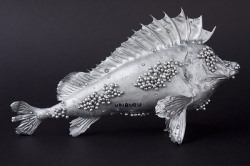Last week the EU and seven of its member states (Bulgaria, Denmark, Hungary, Malta, the Netherlands, Romania, and Sweden) ratified the Minamata Convention on Mercury, thereby providing the “tipping point’’ needed to trigger its entry into force.
Background:Mercury is a chemical with neurotoxic effects, used in industrial processes and in a variety of products like batteries or thermometers. Mercury released to the environment enters the food chain, where it accumulates mainly in fish. Exposure to high levels of mercury can cause harm to the brain, lungs, kidneys and immune system.
Over the past twenty years the EU has developed a comprehensive body of legislation covering all aspects of the mercury lifecycle, from primary mining to waste disposal, including measures on trade, products containing mercury and mercury pollution.
The Minamata Convention on Mercury:
Upon
initiative from the EU, the Minamata Convention on Mercury, the new
global treaty on mercury, was negotiated and
concluded in 2013. The EU
has one of the most ambitious
policies for protection against mercury.
However, as 40 to 80 % of mercury deposited in Europe comes from mercury
emissions in other parts of the world, strong international action is
needed to protect the health of our citizens.
The ratification of
the Minamata Convention on Mercury, confirms Europe's leading role to
protect citizens' health and the environment around the world.
 | Sculpture"Pez-Peste"
(Artist: Nicolas Garcia Uriburu)
The sculpture is the symbol for
the Convention and has followed
the committee throughout the
negotiation process
|
Karmenu Vella, Commissioner for Environment, Fisheries and Maritime Affairs said: “The new global treaty on mercury will help protect millions of people all over the world from exposure to this toxic heavy metal. With ratification, the EU has delivered the decisive bit and triggered its entry into force. This is a great success of EU green diplomacy. It highlights Europe's commitment to strong and concerted international action."
The Minamata Convention, which is named after the location of the worst-ever case of mercury pollution, will not only tighten environmental standards worldwide, but also help create a level playing-field, as all major economies will apply environmental requirements similar to those already in force in the EU.
Pregnant women, infants and children are at particular risk from mercury in the food-chain, and the Convention will bring about significant decreases to their exposure in the long term. For example, by prohibiting the use of dental amalgam for these vulnerable categories.
Given the instrumental role played by the EU in the negotiations on the Minamata Convention, its content is inspired to a great extent by Union legislation. The Mercury Regulation also sets rules that put the EU firmly on track for becoming the first mercury-free economy. This includes putting an end to all uses of mercury in industrial processes and prohibiting any new use of mercury in products and industry, unless proven that it is needed for the protection of health and the environment.
The first meeting of the Conference of the Parties to the Minamata Convention on Mercury will take place from 24-29 September 2017 in Geneva, Switzerland. The High-Level Segment on 28 and 29 September will celebrate the commitment of the international community to the Minamata Convention.
Source: European Commission: Press Release from May 128, 2017
 Related information
Related information
 UNEP: Reducing Risk from Mercury
UNEP: Reducing Risk from Mercury
 UNEP: Minamata Convention text and the status of ratifications
UNEP: Minamata Convention text and the status of ratifications
 European Commission: Fact Sheet: Questions and Answers on EU Mercury Policy and the Minamata Convention
European Commission: Fact Sheet: Questions and Answers on EU Mercury Policy and the Minamata Convention European Commission: REACH: Mercury Policy
European Commission: REACH: Mercury Policy Related EVISA Resources
Related EVISA Resources
 Link Database: Toxicity of Organo-mercury compounds
Link Database: Toxicity of Organo-mercury compounds  Link Database: Mercury exposure through the diet
Link Database: Mercury exposure through the diet  Link Database: Environmental cycling of methylmercury
Link Database: Environmental cycling of methylmercury Link Database: Environmental cycling of inorganic mercury
Link Database: Environmental cycling of inorganic mercury Link Database: Environmental pollution of methylmercury
Link Database: Environmental pollution of methylmercury Link Database: Environmental pollution of inorganic mercury
Link Database: Environmental pollution of inorganic mercury Link Database: Toxicity of mercury
Link Database: Toxicity of mercury  Related EVISA News
Related EVISA News
 October 12, 2013: Minamata Convention is adopted (12.10.2013)
October 12, 2013: Minamata Convention is adopted (12.10.2013) January 21, 2013: UNEP mercury treaty exempts vaccines for children
January 21, 2013: UNEP mercury treaty exempts vaccines for children  January 14, 2013: United Nations Global Mercury Treaty: Fifth and final session
January 14, 2013: United Nations Global Mercury Treaty: Fifth and final session  December 18, 2012: Paediatricians Argue to Keep Thimerosal in Some Vaccines
December 18, 2012: Paediatricians Argue to Keep Thimerosal in Some Vaccines
 December
9, 2012: Mercury in fish more dangerous than previously believed;
Scientists urge for effective treaty ahead of UN talks
December
9, 2012: Mercury in fish more dangerous than previously believed;
Scientists urge for effective treaty ahead of UN talks
 July 15, 2012: World Health Organization Fails In Its Effort To Defend Mercury In Vaccines Before United Nations
July 15, 2012: World Health Organization Fails In Its Effort To Defend Mercury In Vaccines Before United Nations
 October 28, 2011: WHO worries mercury treaty could affect costs and availability of vaccines
October 28, 2011: WHO worries mercury treaty could affect costs and availability of vaccines  August 8, 2011: UNEP Global Mercury Treaty May Include Ban on Mercury in Medicine
August 8, 2011: UNEP Global Mercury Treaty May Include Ban on Mercury in Medicine June 19, 2011: Committee for Socio-economic Analysis agrees on
two draft opinions on restriction proposals for mercury compounds under
REACH
June 19, 2011: Committee for Socio-economic Analysis agrees on
two draft opinions on restriction proposals for mercury compounds under
REACH
last time modified: September 23, 2024